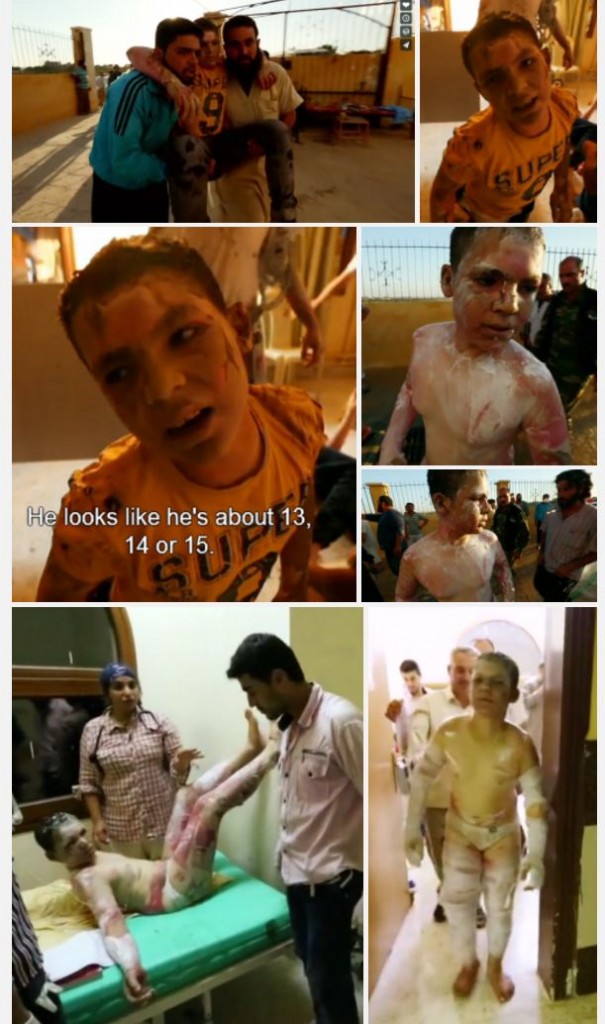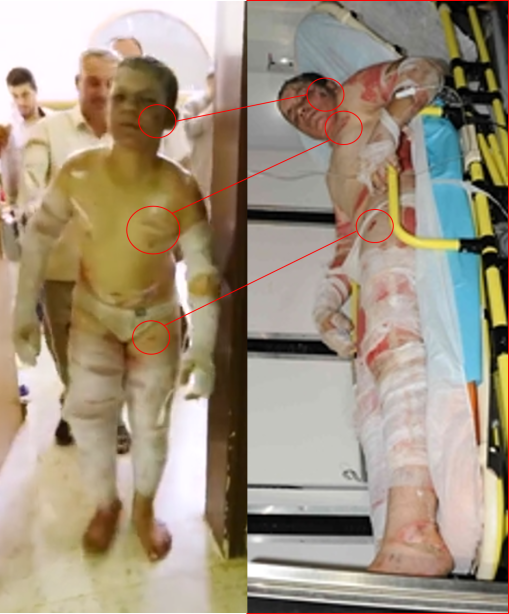BBC Falsely Claimed Incendiary Bomb Victim “Died on His Way to Hospital in Turkey”

Images have emerged which contradict the BBC’s claim that a teenage victim of an alleged 2013 Aleppo incendiary bomb attack died before reaching hospital in Turkey.
In a gallery of images accompanying a contemporary report on the website of Turkish daily newspaper Hürriyet alleged victim Lutfi Arsi is pictured arriving in an ambulance at Reyhanli State Hospital, Turkey. [1]
Alleged incendiary bomb victim Lutfi Arsi (left) arriving at Reyhanli State Hospital,
Turkey on the evening of Monday 26th August 2013. The BBC has stated that Arsi “died on his way to hospital in Turkey”.
Alleged incendiary bomb victim Lutfi Arsi.
Ian Pannell and Darren Conway’s 29 August 2013 report of an alleged Syrian air force attack on a school playground was broadcast on the BBC Ten o’Clock News as parliament voted on whether to launch military strikes on Damascus. OffGuardian observes:
As it happens the motion for intervention was unexpectedly defeated by a narrow majority. If this had not happened the BBC’s footage would unquestionably have served as very timely and useful PR in support of the coming war against Assad.
Fourteen year old Lutfi Arsi, wearing a yellow ‘Super 9’ t-shirt, featured prominently in Pannell and Conway’s report as one of a group of young male victims which begins writhing and groaning in unison, apparently in response to a cue given by the central figure:
In the related BBC Panorama special Saving Syria’s Children, broadcast a month later on 30 September 2013, Arsi is seen being carried into Atareb Hospital, Aleppo by two men (34:05). However in a chronologically later scene (32:26) he is filmed walking around in the hospital yard without any apparent difficulty.
Lutfi Arsi appears at several points in Saving Syria’s Children.
Notably, while the bandages applied to his legs and the white cream on his chest would appear to suggest Arsi had sustained burns in those areas, the boy’s t-shirt and jeans are largely intact upon his arrival at Atareb Hospital.
That the boy in the Hürriyet images is the same person who featured in the BBC’s broadcasts is clear from a comparison of the pattern of alleged injuries:
Lutfi Arsi at 37:52 in Saving Syria’s Children (left) and arriving at Reyhanli State Hospital, Turkey later the same day.
In a response to a complaint alleging fabrication in Pannell and Conway’s report, on 2 December 2013 BBC Complaints wrote:
The other adolescent who kneels up and looks into the camera wearing a t-shirt that reads “Super-9” is fourteen-year-old Luffi Arsi [sic] who was in the playground when the bomb landed. He died on his way to hospital in Turkey.
Ian Pannell’s narration in Saving Syria’s Children states (42:19):
With appalling injuries and limited medical care some of the teenagers didn’t survive: Mohammed Kenas, 14 years old. He died on the way to hospital in Turkey. Anas Said Ali, 18. He’d been waiting to pick up his little sister from school. And 14 year old Lutfi Arsi, who was in the playground when the bomb landed. Three of the ten children who died.
The BBC’s position would therefore appear to be that both Arsi and Kenas died en route to Turkey. However, it is conceivable that BBC Complaints confused Kenas with Arsi in its response. It is incumbent upon the BBC to provide clarification.
Former UK ambassador Craig Murray recently indicated that sources within the BBC had revealed to him that Pannell and Conway’s report had “exaggerated” the severity of the incident and that some scenes had been “filmed again”.
In assessing the authenticity of the alleged injuries in the report note the link between British doctor and ex-army captain Saleyha Ahsan, who was filmed treating the victims, and HOSPEX (“Hospital Exercises”) training exercises, which are run by the British military and involve highly sophisticated injury simulation. A year after Saving Syria’s Children aired, Dr Ahsan presented a BBC Newsnight segment on HOSPEX “macro-simulation” in which she stated:
The principle behind macro simulation is that it’s as close to reality as possible. Actors and make-up artists mimic even the most severe of injuries.
The company which provided the injury simulations featured in the Newsnight report, Trauma FX, promotes itself as the “UK’s leading provider of realistic casualty simulation”. TraumaFX’s website states that it “support(s) various military forces internationally” and “can easily travel international as we are a mobile team and can work in any location”. The company has “over 10 years experience” of supporting UK military training exercises and specialises “in simulating CBRN [Chemical, Biological, Radiological and Nuclear] injuries and conditions”.
Notes
[1] A number of other alleged victims from Ian Pannell and Darren Conway’s 29 August 2013 BBC News report, the related Panorama special Saving Syria’s Children and associated third party footage available on you Tube also appear in the Hürriyet images (the Hürriyet images are first left in all instances below):
Ahmed Darwish http://bit.ly/1KGzVeK
Mohammed Asi http://bit.ly/2kghUgg
Unidentified girl featured in non-BBC footage from Atareb Hospital, Aleppo, 26/8/13 http://bit.ly/2kgtQOU (briefly discussed in the notes here http://bit.ly/1EUkgYv)
Unidentified adolescent male featured in the BBC’s reports, notably the “tableau” scene http://bit.ly/1DlUs70
Ridwan Qambari/Kanbari http://bit.ly/2kgxWXt identified by the BBC as father of alleged female victim Siham Qambari/Kanbari http://bit.ly/1q85tGh (presumably also pictured on gurney)
Unidentfied adolescent male who appears to be grinning broadly in the BBC’s footage http://bit.ly/1zXC16Y
Unidentified male who appears at various points in Saving Syria’s Children
Possibly the supposed teacher who appears in Saving Syria’s Children, swaying and lurching bizarrely, and in associated non-BBC footage http://bit.ly/1FcaK3Q














